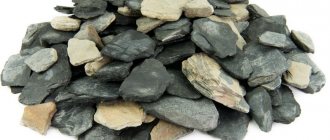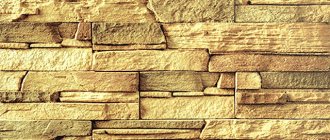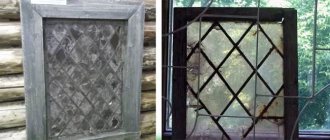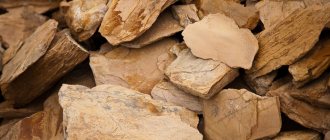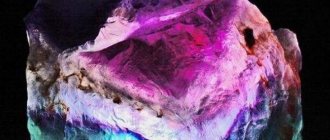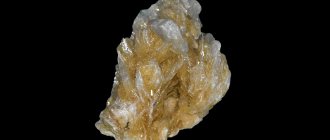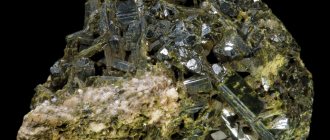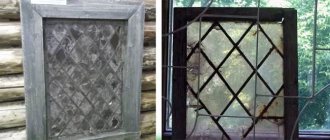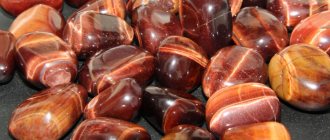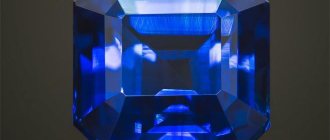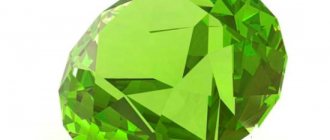What are slates
So, before we talk about clay shales, we must say what kind of rock it is. In fact, shales are different types of rocks with a layered arrangement of mineral intergrowths. Its extraction requires quite a lot of effort, but despite this, it occurs in many parts of our planet.
The extraction of this material will be discussed in more detail a little later. In the meantime, it’s worth talking about the composition of this rather interesting stone.
Properties of the stone
Shale is a rock with a layered structure. The minerals in it are located in parallel. Due to this, the stone easily separates into pieces. The surface of the chip is uneven, the stripes are clearly visible and form an original texture, often with a wave-like layering.
The basis of the rock is composed of dark-colored minerals with feldspars or quartz. Shales (except for fuel) are fireproof, resistant to external factors (withstand temperature fluctuations, are not afraid of water, retain color). All except graphite are characterized by high hardness. Characteristics depend on the chemical composition.
Slate is drilled, split, and cut. Get a stone of any shape and size. The chipped surface is polished, ground or kept unchanged. The treated tile has a velvet surface and a matte finish.
Shale: mineral composition
The mineral composition of shale is quite varied. As the name suggests, stone is primarily composed of minerals. These include sericite, epidote, albite, quartz, etc. In a word, most rocks that belong to low-temperature or medium-temperature materials.
It’s worth mentioning one more point. Shales are divided into several groups according to their mineral composition. After all, they also contain other substances. It was they who became the reason for dividing shale into several types:
- Alum slate. This type of rock includes those whose composition includes carbonaceous matter and sulfur pyrites.
- Roofing slate.
- Slate slate.
- Hone. This type includes those clay shales that contain silica.
- And the last type is slate slate. It can be easily split into small columns.
That, in fact, is all that can be said about the mineral composition of this rock and its varieties.
Sharpening history. Thuringian slate.
One of the most expensive European sharpening natural stones today is the so-called “Thuringian slate”. This stone was mined in the German region of Thuringia from the end of the 18th century until the 60s of the 20th century. For a long time, the stone was considered the best in Europe for finishing razors, knives and carpentry tools. The oil shale was mined in the so-called “Thuringian Forest” (German: Thüringer Wald), a medium-height mountain in the federal state of Thuringia in eastern Germany. The ridge extends southeast from the Werra River, near the valley of the Rodach River, which separates the Thuringian Forest from the Franconian Forest. The length of the mountain range is about 150 km, width up to 35 km. The highest point is the Great Beerberg mountain, 982 meters high. It is a horst (a section of the earth's crust formed as a result of tectonic shifts), composed mainly of gneisses and granites.
From a geological point of view, the Thuringian shale is a weakly metamorphosed clayey shale. Shale is a hard clayey rock of schistose composition that does not soak in water. It comes in dark gray, black, and also pale red or pale green. It is formed during the recrystallization of mudstones (hard rocks formed during the compression of clays), at the last stage of lithogenesis, at temperatures of 200–350 ° C and enormous pressures, at depths of over 6 km. It is clay compacted and modified by pressure and later metamorphic processes. Formed from very small particles of various clay minerals (kaolinite, sericite, chlorite, talc, gumbelite, pyrophellite and other substances). Shale has a porosity of the substance in the range of 1–3%. Contains inclusions of fragments of quartz, feldspars, mica, etc. It is believed that the shales were formed in the Upper Devonian (375-385 million years).
A rock of character for sedimentary formations of folded regions (known in the Greater Caucasus, the Urals, Altai, Sayan Mountains, etc.). They lie at the base of deep depressions (aulacogens) of geological platforms. There are several types of slates:
- Roofing slate is a black rock that easily splits into thin, even plates. They are used for roofing work, as well as for external and internal wall cladding.
- Slate slate (slate) - has a soft structure, splits into long columns. It is used for roofing work; previously it was used to make slates and slate writing boards.
- Drawing slate is a soft, black rock.
- Alum shale is a loose black rock impregnated with carbonaceous matter and a large amount of iron sulfides, a transitional form to oil shale.
- Whetstone is a high-hard rock rich in silica that is the basis of a wide variety of sharpening stones, including Atlante slate, Welsh slate, Belgian and Thuringian stones.
The main company selling Thuringian slate is the Escher company. The company changed its name several times during its history, which led to changes in the logos that were applied to the stones (Escher & Co. Shortened E & Co., Escher & Sohn, Escher & Son, JG Escher & Sohn Shortened JGES). The company was founded in 1789 in Sonneberg by Johann Gottfried Escher. He was engaged in the trade of various stones for jewelers, stone carvers, hairdressers, etc. The stones were mined in the Steinach region of Thuringia by small family firms, and then purchased by the Ascher company. They were also exported in large quantities, primarily to the USA. After World War II, the production of natural stones was depleted, and the company switched to the production of artificial ones. The last miner of natural water stones in the Thuringian region is Hermann Luthardt, who stopped mining in 1966. Modern stones sold under the name "Thuringian slate" are produced by MST, but are not mined in Thuringia. Their abrasiveness is rated at 6000-8000 grit (JIS), in addition, they have a high content of pyrite crystals, which can scratch the liner during the polishing process.
Photo: wren. Source: https://forum.guns.ru/forum_light_message/224/1323542.html
The main abrasive substance of Thuringian slate is small and uniform in size quartz crystals. In terms of abrasiveness, the stones are approximately equal to 12-15 thousand grits (according to JIS), that is, they are suitable for ultra-fine finishing polishing. Thuringian shales come in different colors, this is primarily determined by the amount of chlorite and other impurities. The darker the color of the stone, the deeper it lay in the rock and the more dense its structure. Thus, the lightest stones (green-blue) are the softest, and the darkest are the hardest. Yellow-green stones are among the most homogeneous in composition, the quartz content in them is lower, and the quartz particles themselves are smaller in size than in blue stones. Blue stones are colored this color due to the presence of large amounts of ore, opaque materials and bitumen. Stones in the green-blue category are the rarest and one of the most expensive.
Photo: Impulse1977. Source: https://forum.guns.ru/forum_light_message/224/1323542.html It is important to note that light stones work faster due to a more abundant release of suspension. But at the same time, the production of such stones is accelerated. Harder slates produce relatively little suspension, work noticeably slower, but leave more aggression after sharpening. Like any natural stones, Thuringian slates require leveling. They work only with water, while soft ones require more frequent spraying than harder ones. The main quality of Thuringian slate is its softness of work. The blade glides smoothly over the stone, without scratching it, but at the same time without slipping. These stones can be used to finish straight razors, knives and any other tool. At the same time, with all the advantages of Thuringian stone, experienced sharpeners still note that Thuringian slates are inferior to Japanese natural stones, since they are produced more slowly, are easier to level and are cheaper.
Source: https://roks-ru.com/p458155675-tyuringskij-slanets-175h50h24mm.html
Today the stone is in great demand among collectors. Thuringian slates have a high price, but also the highest reputation among finishing stones. This is due to the low percentage of defective specimens and the guaranteed high performance of this stone.
Application of the breed in question
This type of breed has been known since time immemorial. All over the world you can find buildings whose roofs are covered with roofing material made from it.
Where is shale used nowadays? The use of this fossil is quite large, but it is mainly used to create roofing, cladding and slate materials.
The stone is very popular for several reasons. First of all, because clay shales do not contain absolutely any harmful chemical impurities. And in our time, when almost every building material contains substances hazardous to our health, this method of finishing is simply worth its weight in gold. In addition, this stone is quite strong and reliable. The service life of such building material is more than a dozen years.
Quite often, bathrooms are finished with clay slate. This is due to the fact that the rock perfectly absorbs all moisture and this does not affect its service life in any way. What material can compare with this type of rock? Essentially none. The density of shale, its long service life and versatility make this material indispensable.
Types of slate
Slate is a collective name. In general, they can be divided into clayey and crystalline. The former consist of clay minerals, hydromica. The second ones are mica, they are close to gneisses (quartz, potassium feldspar, plagioclase, non-ferrous minerals). Sometimes they are called by the presence of a rare mineral - garnet, staurolite, kyanite. Due to their strength and heat resistance, crystalline shales are often used as a building material and fire-resistant raw material.
Shale is a hard rock that is dark grey, black in color. There are greenish and reddish shades. It consists of small particles of clayey rocks (hydromica, chlorite, etc.), oriented strictly parallel. It contains crystals of sulfur pyrites, veins of quartz, grains of calcareous quartz, and mica.
Clay slate is divided into roofing slate (“natural slate”) and slate. Until the 19th century roofing stone was used only for roofs, then they began to be used for interior and exterior decoration of houses. “Natural slate” - dark gray, blue, purple, black, green, red. Rock blocks are split into 0.5-2 cm tiles (60x30), which are used for roofing and cladding of buildings. The material is resistant to UV radiation, very durable, lasts up to 100 years or more.
Slate (or shungite) is found as an impurity in shungite shales and dolomites. The substance is a mixture of various carbon allotropes. There are 2 varieties - shiny and matte gray. Application: for aquarium, terrarium, pond, interior decoration.
Phyllites, chlorite schists and green schists are in the range between clayey and crystalline - in addition to mica, they contain many green minerals (chlorite, epidote and amphiboles). Greenshales are formed from sedimentary and volcanic rocks. Chlorite green slate is distinguished by its bright shine, the base is chlorite, and also contains actinolite, talc, mica, epidote, quartz, etc.
Siliceous shale - consists of fine-crystalline quartz formations with the presence of chalcedony. It comes in black, grey, red, green or grey-violet (quartz, feldspar and dark colored minerals).
How is this rock mined?
Mining of the mineral is carried out in almost every corner of the Earth: Spain, Brazil, the United States of America. Russia also does not lag behind its competitors. Basically, rock mining is carried out in Siberia, as well as in the Urals, Kostroma and Kirov regions.
Unfortunately, at the moment, clay shales mined in Russia are not very popular, as a result of which it is bought abroad. So what is the reason for this unpopularity of the material? There are two reasons:
- Underdevelopment of the roofing slate market in Russia. That is why mining this rock is far from profitable.
- Low quality.
The material is mined in open pits. The rock layer is chipped off and further split into smaller pieces. Bulldozers and excavators are mainly used for mining.
Medicinal properties
The stone in question has miraculous healing properties. According to experts, shale has a positive effect on absolutely the entire human nervous system. Great for relieving stress. That is why quite often this magnificent stone can be found in the interior of bedrooms or living rooms.
Another way to use oil shale for medicinal purposes is to purify water. The rock under study perfectly filters water from impurities of chlorine and heavy metals.
In addition, the stone is used in application procedures.
Properties and uses of stone
Shale is used in many industries:
- It is used in construction for cladding buildings, making paths and roofing. The mineral is a ready-made building material.
- Roofing slate in black and gray shades is so smooth when divided into layers that it is used in the production of billiard tables and some furniture.
- The structural features of the stone make it possible to make high-quality electrical devices from it. Due to its layered structure, it has high electrical conductivity.
- In crushed form, minerals are used in the manufacture of rubber products.
Shale is considered a high quality material. Its physical characteristics make it possible to make strong, durable products from it, and to use it as a reliable building material.
To watch a video about the use of this breed:
Physical properties
Among the physical features of the stone are the following:
- hardness: 2–6 on the Mohs scale, depending on the type of slate;
- traces of quartz, chlorine, mica, coal or silicon are often found in the mineral composition of shale;
- porosity: 1–3%;
- the siliceous rock has a crystalline structure;
- the remaining shales are characterized by a layered structure;
- greasy shine;
- comes in different shades, the most common are black and gray;
View this post on Instagram
Publication from Margarita Kolbina (@ritakolbina) July 20, 2015 at 5:01 PDT
Medicinal properties
Lithotherapists note the beneficial properties of the stone in the treatment of various diseases. From the observations of specialists:
- The stone helps get rid of insomnia and alleviates mental disorders. It has a beneficial effect on the nervous system, restoring after stress.
- The mineral improves your mood and helps you become more efficient. Helps improve memory and concentration.
- Harmonizes the emotional background, has a beneficial effect on the general condition of the body.
Houses built using clay shale have a positive effect on human health.
If you do not have the opportunity to use the mineral in the form of a building material, purchase decorative clay slate and be content with its healing properties.
Have you used slate materials in the construction of your house? Write if you have noticed its healing effects on yourself, share the article on social networks.
Mystical features of the material
Now you can turn to the magical properties of this material. Mages are confident that with the help of this stone you can get rid of mental pain in the shortest possible time, which is associated, for example, with a break in a relationship with a loved one.
Also, a pebble can serve as an excellent amulet. Slate protects against negativity and other problems that people quite often face. This decoration is especially suitable for people who are closely associated with creativity. This stone promotes the development of talent in a person, helps to create new interesting and unusual things. You can buy it at absolutely any jewelry store. It is used in many decorations.
Astrologers claim that slate suits almost all zodiac signs. The only exceptions are Capricorn and Aries. The stone is strictly contraindicated for them.
